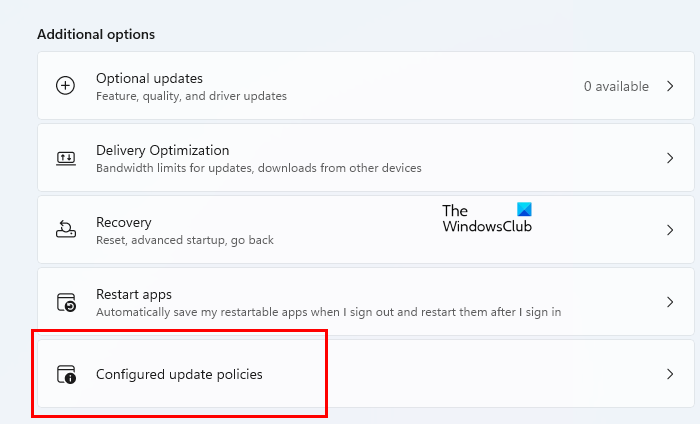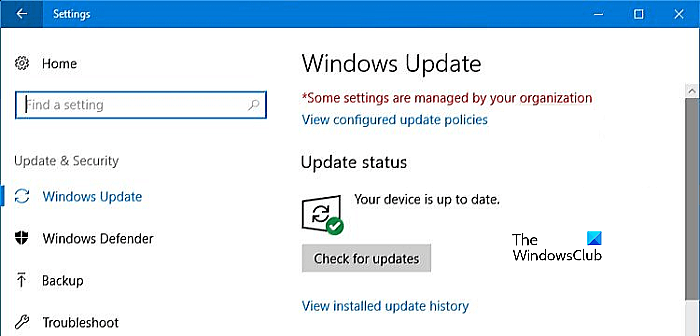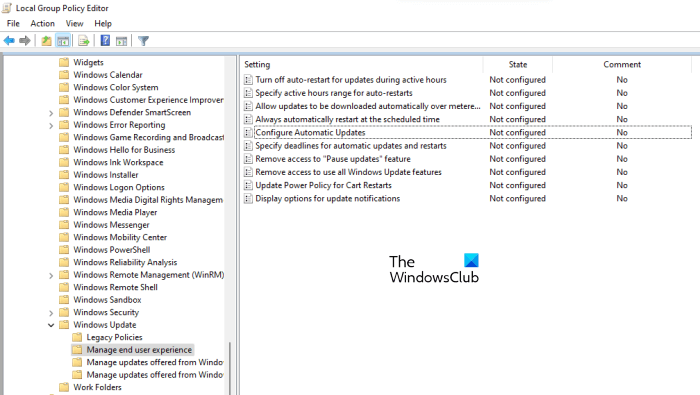If you have Windows 11/10 Pro or Enterprise edition, you may see the “Some settings are managed by your organization” message on the Windows Update page. Windows displays this message when your organization has configured some Windows Update Policies. If you have a personal computer with Windows 11/10 Pro or Enterprise edition, you can also configure Windows Update Policies. In this article, we will show you how to view the Configured Windows Update Policies applied to your computer.

How to view Configured Windows Update Policies applied to your computer
The following instructions will show you how to view Configured Windows Update Policies applied to your computer. Because of a change in UI, the steps to view configured Windows Update Policies are different for Windows 10 and Windows 11 users.
Windows 11
Windows 11 users have to follow the following steps to view configured update policies on their computers:

- Open Windows 11 Settings.
- Select Windows Update from the left side.
- Now, click Advanced options.
- Scroll down and then click Configured update policies.
After that, Windows 11 will show you all the update policies configured on your system.
Windows 10
If you have Windows 10, you can view the configured Windows Update Policies by following the steps written below:

- Open Windows 10 Settings.
- Select Update & security.
- Now, select Windows Update from the left side.
- Click on the “View configured update policies” link under the “Some settings are managed by your organization” message on the Windows Update page.
After performing the above steps, you will see all the update policies configured on your Windows 10 device.
How to change Configured Windows Update Policies applied to your computer
We have seen how to view configured Windows Update Policies applied to your computer. Now, let’s see if you want to change these Windows Update Policies, how can you do that? You can change the configured Windows Update Policies by using the Local Group Policy Editor. The Local Group Policy Editor is not available on Windows 11/10 Home edition.

Do note that you need an administrative account to change the configured Windows Update Policies. Go through the following instructions to change configured Windows Update Policies applied to your computer:
- Open the Run command box by pressing the Win + R keys.
- Type
gpedit.mscand click OK. This will open the Local Group Policy Editor. - Now, expand Computer Configuration.
- Go to “Administrative Templates > Windows Components > Windows Update.”
You will see the following four types of Settings under the Windows Update category and on the right pane:
- Legacy Policies
- Manage end user experience
- Manage updates offered from Windows Server Update Service
- Manage updates offered from Windows update
Double-click on any of the above Settings to view Windows Update Policies. You can view the status of all the updated policies. Let’s see what different statuses mean:
- Not configured: This status means that the particular update policy is not configured on your computer.
- Enabled: This status shows that the particular update policy is configured on your computer.
- Disabled: This status means that the particular update policy is disabled on your computer.
To configure a Windows Update policy or change the configured update policy, double-click on it and change its settings accordingly.
Related read: Your organization has set some policies to manage updates.
How do I change Windows Update Policies?
To change Windows Update in Group Policy, open the Local Group Policy Editor and go to “Computer Configuration > Administrative Templates > Windows Components > Windows Update.” Now, double-click on any of the settings on the right side to view and change the Windows Update Policies.
Read: Limit Bandwidth and set the Time when Windows Updates can download
How do I remove a configured update policy?
You can remove a configured update policy via the Local Group Policy Editor. But for this, you need to log in to Windows using an administrative account. Open the Local Group Policy Editor and go to “Computer Configuration > Administrative Templates > Windows Components > Windows Update.” Now, open a configured Windows Update policy and select Disabled.
Read next: Recommended Windows Update policies Admins should be using.
Leave a Reply